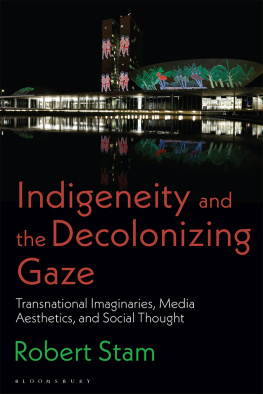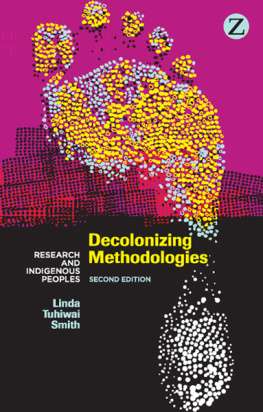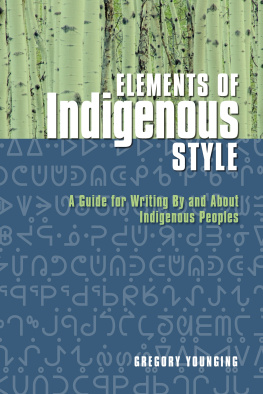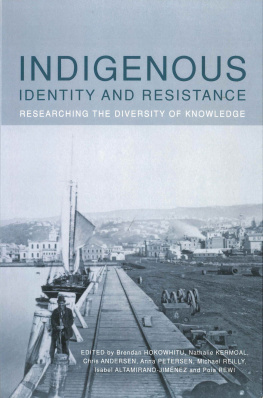Indigeneity and the Decolonizing Gaze
Indigeneity and the Decolonizing Gaze
Transnational Imaginaries, Media Aesthetics, and Social Thought
Robert Stam

To Deana Bowman Stam, Marcelo Fiorini, and Rafaela Vargas
Contents
Although I have been contemplating writing a book like this for at least four decades, only recently have I had the time and courage to complete it. I write this text in the conviction that when one begins to consider fundamental issues from an indigenous point of view, that view, however inadequately grasped, changes ones thinking in a way that is both humbling and exhilarating. I see the book not as an issue of speaking for but rather of listening to and heeding indigenous thought.
Although I have touched lightly on indigenous-related issues since the 1980s, and although I have long been writing critically about colonialism, genocide, and anti-indigenous racism, as well as about indigenous media, I have never done so at such length or as my sole focus. The critique of racist and colonialist imagery, on the one hand, and the celebration of indigenous culture and media, on the other, held a central place in the book co-authored with Ella Shohat, Unthinking Eurocentrism (published in 1994, with a second edition in 2014 having a new Afterword, which included updated material on indigenous issues). The original version was written in the context of the anti-quincentennial protests in 1992. I organized a film series and taught an anti-quincentennial course at NYU, while Ella, together with Annette Jaimes (Juaneno/Yaqui), organized a Goodbye Columbus Conference at Cornell featuring Jaime Barreiro (Taino), Ward Churchill (Creek, Cherokee, Metis), and Terry Turner. Much of the writing and thinking here on Columbus and colonialism goes back to that period but here recast in the light of new scholarship and a new situation.
The current book, like most of my books, reflects my academic and personal entanglement, for most of my adult life, with the places and cultural zones where I have lived and taught: the United States, Brazil (and to a lesser degree Portugal), France, North Africa (Tunisia), and the larger Arab World (Abu Dhabi). Living and working in those places has deeply affected my research and thinking and my realization that the history and social thought of the native peoples of the Americas are of central importance not only to the history of the Americas but also to the history of Europe and the world. My work takes place along the interface, the shifting borders between indigenous thought/art, and what we broadly call the radical left, a left whose limitations become obvious when one considers issues from an indigenous point of view.
This project crystalized over the years thanks to a number of people and institutions linked to pro-indigenous arts and activism at NYU and elsewhere. The earliest connection and longest collaboration has been with Faye Ginsburg and the Center for Media, Culture, and History at NYU and the various symposia, panels, and film festivals that she has organized in support of indigenous media. Faye has played an indispensable role not only in advancing the indigenous media cause but also in theorizing the movement through her influential concepts of embedded aesthetics and the Faustian dilemma. Although I had already encountered indigenous media makers from Brazil, thanks to my innumerable stays there and Fayes various programs, I was able to see countless indigenous films and meet many indigenous directors, intellectuals, and curators such as Rachel Perkins, Loretta Todd, and many others. Fayes energetic support for indigenous projects has had a major impact on the film world. A number of indigenous filmmakers were nurtured by her program, such as Jacob Floyd (Muscogee [Creek] Cherokee), whose film Tonto Plays Himself (2010) is discussed in this book, and Teresa Montoya (Din), who directed Doing the Sheep Good (2013), which revisits the Sol Worth Seeing through Navajo Eyes; and Angelo Baca (Din/Hopi), whose film Shash Jaa (Bears Ears, 2016) discusses the anti-extraction efforts to protect a huge area of wilderness sacred to five tribal nations (Navajo, Ute, Ute Mountain Ute, Hopi, and Zuni).
I also want to thank Diana Taylor not only for her brilliant scholarship but also for her role in creating the trilingual Hemispheric Institute of Politics and Performance, which has often focalized indigenous issues and performance, leading to numerous events and performances and an archive of colonial and indigenous materials. The Hemis Encuentros in Lima, Peru, Monterey Mexico, Rio de Janeiro, and New York offered the participants unforgettable experiences and new forms of knowledge.
I also want to thank Cornells School of Criticism and Theory, which invited Ella Shohat and me to co-teach in their summer program in 2006. Although our course had to do with colonialism in general, our public lecture, entitled Tupi or not Tupi a Tupi Theorist, contained the kernel of what was to become of this book. We thank Valery Velejo for introducing our talk. We also learned from Verona Monja and Brent Hayes Edwards as fellow participants in the program. And thanks to Dominick la Capra not only as Director of the Program but also for his irresistibly carnivalesque parodies of academic discourse.
I also want to thank Princetons Shelby Cullom Davis Center for Historical Studies and its then director Daniel T. Rodgers for granting me a fellowship in 2009, which allowed me to expand on the ideas first developed in the talk at Cornell, entitled The Red Atlantic: Tupi Theory and the Franco-Brazilian-Indigenous Dialogue.
I would like to thank Sandy Grande for giving Ella and me the tremendous honor of dialoguing with her groundbreaking work on Red Pedagogy in the 10th Anniversary Edition of the book.
Finally, I want to thank the Wissenschaftskolleg zu Berlin (WIKO) for granting my partner Ella a fellowship in Berlin for 202021, giving her a year to write up her research on Arab Jews, and as a glorious by-product, allowing me to take advantage of a sabbatical and a leave to write up this project. I am especially grateful for the generous help of WIKOs amazing library services, which, despite Covid, was capable of finding the relevant books in English, French, Spanish, and Portuguese, all done with remarkable speed and goodwill. I could not have completed this project without the time allowed to me by that grant. Special thanks go to Vera Pfefer, Anja Brockmann, and Dunia for the immense kindness and hospitality they offered us while we were there.
I also owe a great debt to my former PhD advisee/now friend Amalia Cordova, the kind of student from whom one learns as much as one teaches. A much-beloved figure in many different communities, Amalia is admired for her intelligence, courage, writing, and tireless activism in the cause of indigenous media and culture.
The intellectual conversations promoted by various centers at NYU have been an endless source of stimulation and inspiration. Here I would like to thank Frederic Viguier from La Maison Francaise; Juan Fernandes, Omar Alejandro Dauhajre, and Ana Dopico at the Juan Carlos of Spain Center; Jill Lane from the Center for Latin American and Caribbean Studies, Culture and History, along with the Comparative Race Studies Group led by Pamela Calla.
I am dedicating this book to two people who for me embody living breathing love art, and activism: Marcelo Fiorini and Rafaela Vargas. Marcelo and I have been close friends ever since he prepared caipirinhas for the students in my Brazilian cinema course many decades ago. The friendship began in New York when he was completing his doctorate at NYU, but it continued and flourished in France and Brazil. Wherever Marcelo and Rafaela go, they bring joy, love, activism, and a festive spirituality, creating an atmosphere where friends become friends of other peoples friends, and where people fall in love and meet fellow activists, creating transnational circles of socially engaged people. Marcelo lived with the indigenous Nambiquara for five years and speaks two dialects of the language fluently. For 35 years, he has been a risk-taking advocate of indigenous causes in Brazil, actively working for the demarcation of indigenous lands, including the first sacred (Nambiquara) territory in Brazil, which guards important Amazon sources and is crucial to their cultural reproduction. Among his many films is the feature-length documentary
Next page








